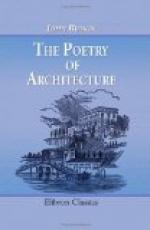63. In the cottage, therefore, a building peculiarly adapted for scenes of peace, the chimney, as conducting the eye to what is agreeable, may be considered as important, and, if well managed, a beautiful accompaniment. But in buildings of a higher class, smoke ceases to be interesting. Owing to their general greater elevation, it is relieved against the sky, instead of against a dark background, thereby losing the fine silvery blue,—which among trees, or rising out of a distant country, is so exquisitely beautiful,—and assuming a dingy yellowish black: its motion becomes useless; for the idea of stillness is no longer desirable, or, at least, no longer attainable, being interrupted by the nature of the building itself: and, finally, the associations it arouses are not dignified; we may think of a comfortable fireside, perhaps, but are quite as likely to dream of kitchens, and spits, and shoulders of mutton. None of these imaginations are in their place, if the character of the building be elevated; they are barely tolerable in the dwelling house and the street. Now, when smoke is objectionable, it is certainly improper to direct attention to the chimney; and, therefore, for two weighty reasons, decorated chimneys, of any sort or size whatsoever, are inexcusable barbarisms; first, because, where smoke is beautiful, decoration is unsuited to the building; and secondly, because, where smoke is ugly, decoration directs attention to its ugliness.
64. It is unfortunately a prevailing idea with some of our architects, that what is a disagreeable object in itself may be relieved or concealed by lavish ornament; and there never was a greater mistake. It should be a general principle, that what is intrinsically ugly should be utterly destitute of ornament, that the eye may not be drawn to it. The pretended skulls of the three Magi at Cologne are set in gold, and have a diamond in each eye; and are a thousand times more ghastly than if their brown bones had been left in peace. Such an error as this ought never to be committed in architecture. If any part of the building has disagreeable associations connected with it, let it alone: do not ornament it. Keep it subdued, and simply adapted to its use; and the eye will not go to it, nor quarrel with it. It would have been well if this principle had been kept in view in the renewal of some of the public




